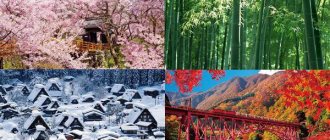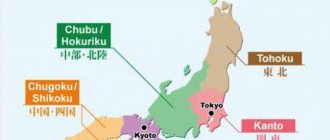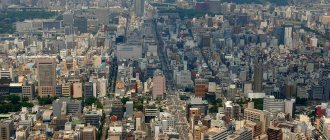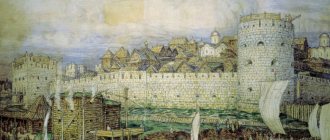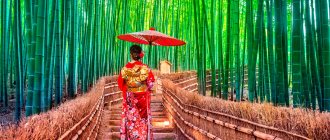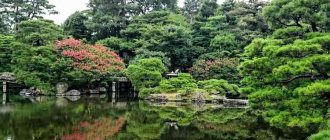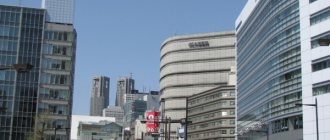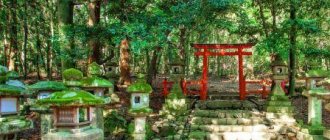Sights of Japan with photos and descriptions. What to see in Japan depending on the city you choose. Historical, architectural and natural attractions. Prices for excursions.
Having opened up to the world after a long period of isolation, Japan is still considered a mysterious and incomprehensible country in the eyes of Europeans. Tourists are interested in everything - advanced technologies, ancient culture, art, attitude towards nature. There is only one problem - to have time to see at least the main attractions of Japan in 10 days.
Therefore, the first thing tourists should acquire is a map of Japan with attractions in Russian.
Sacred Mount Fuji
© kimura2 / pixabay.com / CC BY 2.0
When asked what to see first in Japan, the answer is clear – of course, Fuji! This active young volcano is especially revered by local residents. Every Japanese strives to experience the strength of spirit by climbing to the top of a mountain and seeing the sunrise there. Tourists appreciated the harsh beauty of the snowy pyramid, and today Fuji opens the top 10 iconic places.
While architectural attractions are accessible at any time of the year, climbing Mount Fuji is only permitted in July and August . The rest of the time the mountain is closed to visitors due to weather conditions.
How to get there: Buses leave every hour from Shinjuku After 2 hours you will find yourself at the 5th station, where the walking ascent begins. Another hour's drive and you're in the Fujikyu Highlands in the Five Lakes area.
What to see first in Japan
For a European, any Japanese city is an attraction in itself, but in all its diversity there are those objects that every traveler should see. Practice shows that guides in Japan are irreplaceable, because without them it will not be possible to understand complex local traditions and learn ancient secrets hidden by advanced technologies.
Fushimi-inari Temple (Kyoto)
Scarlet torii
One of the historical symbols of Japan is the Fushimi-Inari Shrine or the Shrine of a Thousand Scarlet Gates, dedicated to the goddess of rice fertility. Grandiose tunnels with portals intended for the gods were created according to the beliefs of Shintoism. The Japanese believe that visiting the Fushimi Inari Shrine brings success and prosperity. Don't hesitate what to see in Japan. Features of the sacred complex in Kyoto will leave a lasting impression:
- The central gate of the sanctuary is decorated with two foxes. They are the most revered animals of Japanese folklore and mythology.
- When visiting the Temple, you need to follow a clear ritual, the first condition of which is a mandatory donation. It is left in the offertory - a coin box.
- The sacred complex consists of five main shrines, connected by tunnels of torii gates. They are people's donations to the Temple.
It is better to visit Fushimi-Inari at night to enjoy the mysterious and mystical atmosphere of the thousand scarlet gates. The pilgrimage through the long tunnel lasts a couple of hours, then travelers find themselves in the main sanctuary. Along the way you can see many fox statues, small chapels and graves. Halfway along the route there is an observation deck with a beautiful view of the city of Kyoto.
Official website: www. inari.jp/en/
Tree of Heaven (Tokyo)
The beauty of Tokyo in spring
The Tokyo Sky Tree is the second tallest TV tower in the world. This elegant architectural structure made of glass, concrete and metal soared into the sky thanks to the efforts of experienced designers and engineers. The height of the structure is 634 meters. Half a million people worked on this project. The grandiose Tokyo sky tree tower is worthy of admiration:
- Guides in Tokyo will definitely organize a visit to the Tokyo Sky Tree, which amazes with its height.
- Tourists will be able to contemplate the capital of Japan, which is spread out in full view at the foot of a huge television tower.
- There are no open areas or balconies here, so panoramic shots can only be taken through glass.
- It is noteworthy that the roof of the television tower is located at an altitude of 470 meters, and the rest of the footage is the antenna.
- The first observation deck is located at a 350-meter height and can accommodate up to 2,000 people, and the second spirals around the spire, receiving up to 900 visitors.
A breathtaking sight opens from the grandiose heights of the Tokyo Sky Tree. Excursions to Tokyo must include a visit to the capital's TV tower, which is one of the three tallest buildings in the world.
Official website: https://www.tokyo-skytree.jp
Garbage Island (Tokyo)
Rainbow Bridge and Miniature Statue of Liberty on Odaiba Island
A futuristic city of the future is located on Odaiba Island in Tokyo Harbor. This is a paradise for pedestrians, a holiday city glowing with thousands of lights. Why did the island get the name Garbage? In 1979, it was merged with a garbage dump, which did not stop the original place from developing at a rapid pace. Trash Island is connected to Tokyo by the Rainbow Bridge. You can get to the island by monorail, which winds in an intricate loop over Tokyo Harbor, as well as by water buses or on a special ship resembling a space shuttle. The impressions from the excursion are simply unreal! In this city of the future, the headquarters of major corporations are located.
The attention of travelers is attracted by the titanium Fuji-TV ball, shopping mall, Tokyo Joypolis attractions and a hundred-meter Ferris wheel. Trash Island has a lot to see in Japan. This is a robot skyscraper, a copy of the Statue of Liberty, exhibits of the Toyota automobile brand, and a museum ship. But the island is especially beautiful at night in the light of bright lights. From the Telecom Center site there is a wonderful view of the Rainbow Bridge at night.
Asakusa area (Tokyo)
Sensoji Buddhist Temple
The sights of Japan are unique and inimitable. These include the Asakusa district in central Tokyo, which has an old-town atmosphere. It is here that the Japanese flavor dominates the urbanization of the huge metropolis. Interesting places and architectural monuments are located within walking distance, but you can use the services of a rickshaw.
What to see in Japan in the Asakusa area:
- Sensoji Temple Complex.
- Buddhist temple Asakusa.
- Nakamise-dori souvenir street.
In the Asakusa area, Japanese traditions are sacredly respected; there is absolutely no traffic on the streets, but there are many cozy restaurants and cafes with Japanese cuisine, there are souvenir shops and shops where you can buy original jewelry, sweets, magical amulets and fragrant incense.
Asakusa Kannon Shrine attracts the largest number of tourists. A popular national festival, the Sanja Matsuri, is held on the territory of the sanctuary in May. At the approaches to the temple there are small chapels, and in front of the entrance to the main hall there is an incense burner. It is the Asakusa area that reflects the originality of Japanese culture and traditions.
Tsukiji Fish Market (Tokyo)
Dishes of national Japanese cuisine
Tourists have the question “What to do at the fish market?” Indeed, fish markets are rarely considered attractions, but are perceived as shopping outlets, but not Tsukiji Market, located in the very heart of Tokyo. It has gained immense popularity among tourists who know what to visit in Japan. Every day up to two thousand tons of fresh fish and seafood are processed here.
At three o'clock in the morning the first workers appear at the Tsukiji Inner Market, and throughout the morning there is brisk trade and profitable deals are made. Most of the fish ends up in local restaurants, where they prepare gourmet dishes. The main “attraction” at the market is tuna, or rather, the tuna auction. What does it mean:
- Sellers carefully select the best fish products.
- Selected carcasses are numbered and put up for sale.
- The tails of the carcasses are cut off and a longitudinal cut is made.
- Buyers carefully examine the fish pulp.
- Bidding starts at the signal, and the fish are sent to clients.
When Tokyo offices are just opening, Tsukiji Market is already finishing its work. In local restaurants you can taste delicious sushi prepared strictly according to the traditional recipe.
Official website: https://www.tsukiji-market.or.jp
Check out the beautiful places in Japan in this wonderful video!
Sagano Bamboo Forest (Kyoto)
Path in a bamboo forest
A picturesque bamboo grove of thousands of tall evergreen trees is the hallmark of Kyoto Prefecture. Among the urban infrastructure, it is surprising to see such a green miracle. The smooth tree trunks of the Sagano forest cover an area of 16 square kilometers. The protected area of the Arashiyama tourist area is protected by UNESCO. The bamboo forest is a must-see in Japan. Features of Sagano Forest:
- To explore the forest completely, rent a bicycle at the entrance to the park.
- When the wind blows, the bamboo stems make musical sounds.
- The bamboo grove is crossed by hundreds of alleys and footpaths.
- The largest bamboo stalks in the Sagano forest reach 40 m in height.
- In the forest there is a pond called Sojen, on the banks of which there are temple buildings.
In Japan, they believe that bamboo protects against evil spirits, which is why many temples are surrounded by tree stems. In the Sagano region, durable bamboo is used to weave baskets, boxes and some utensils. The natural attractions of Japan amaze with their beauty, and the bamboo grove ranks high on this list. All tourists who are in search of harmony and peace of mind should visit the Sagano Forest in Arashiyama Park. This Kyoto landmark can easily be included in the list of the most beautiful places on Earth.
Snow monkeys in hot springs (Nagano)
Monkeys in a hot thermal spring
In the valley of the Yokoyu River, at an altitude of 850 meters above sea level, there is a unique park of snow monkeys called Jigokudani, famous among travelers. Japanese macaques demonstrate original behavior. The area is covered with snow for a third of the year, but thanks to the presence of hot springs, snow monkeys can live in Nagano. They soak in the pools as if they were in hot baths.
The official opening of Jigokudani Park took place in 1964. Very soon this unique area gained worldwide fame and popularity. What to see in Japan if not a quaint natural area inhabited by smart monkeys? Tourists have the opportunity to take beautiful pictures of macaques and observe their behavior. Monkeys can easily withstand air temperatures down to –15°C. Since the northern macaque species is on the verge of extinction, the animals are taken under the protection of relevant organizations.
In summer and spring, snow monkeys travel through the forest, jumping from tree to tree, and in the cold season they bask in the waters of thermal springs. Whole families of Japanese macaques splash in warm baths, getting real pleasure. Interestingly, monkeys with dry fur bring food directly to their relatives’ pools.
Since the park's springs are not fenced, visitors to the protected area can freely observe the macaques. Monkeys can be filmed and photographed, but this must be done carefully so as not to frighten them.
Official website: https://en.jigokudani-yaenkoen.co.jp/
Golden Pavilion (Kyoto)
Golden Pavilion on the shore of the “Mirror Lake”
The Golden Pavilion – Kinkakuji is considered the pearl of the architectural collection of Japan. The palace, covered with gold, amazes with its beauty and luxury. Other attractions in Japan cannot compare with it. The beautiful palace was built in 1397. Its walls sparkle in the sun with incomprehensible beauty. Kinkakuji is part of the Rokuonji temple complex and is considered the best example of national culture. What is remarkable about the Golden Pavilion?
The architecture of the palace harmoniously combines various styles: the aristocracy of the Heian era, samurai simplicity and the asceticism of a monastic cell. The disparate architectural trends were tied together by the overall design of the palace with the thinnest sheets of gold leaf.
The top of the Golden Pavilion is crowned with a phoenix figurine made of pure gold. It symbolizes rebirth. The three-tiered palace amazes with the symmetry of curved lines and is fully consistent with the architectural style of karae.
What is especially striking is how harmoniously the Golden Pavilion blends with the surrounding nature. The lower supports look impressive against the background of the trunks of neighboring trees, and the building itself is located on the shore of a man-made lake. The weightless and light Golden Palace is included in the architectural attractions of Japan.
Mount Fuji (Honshu Island)
Fudshi-san - the sacred mountain of the Japanese
The symbol of the land of the rising sun is the sacred Mount Fuji. What to visit in Japan outside the capital? You should definitely see the young Fuji volcano up close. The Japanese believe that the mountain was created by the gods out of chaos. This is the most recognizable landmark in the country. The majestic mountain peak rises to the heavens to a height of 3776 meters. Many pilgrims climb Mount Fuji. Along the way there are stations where tourists can rest. There is a lot of entertainment in the vicinity of the mountain. Mount Fuji is surrounded by five lakes in a bizarre arc:
- Yamanaka-ko is the largest lake at the foot.
- Kawaguchi-ko is famous for walks along its shore.
- Sai-ko has excellent trout fishing.
- Shoji-ko is a small beautiful lake.
- Motosu-ko is the clearest and deepest lake.
In clear waters in calm and clear weather, the majestic lonely peak of Fuji is reflected, as if in a mirror. Between the lakes lies the gloomy Jukai forest, which is easy to enter but difficult to get out because you can get lost. Nearby there is a pleasant picnic spot - the 26-meter-high Shiraito Falls. The surrounding area of Mount Fuji is a great place to get to know Japan's natural attractions.
Official website: https://www.fujisan-climb.jp/en/
Himeji (Honshu Island)
White Heron Castle
The oldest castle in Japan is Himeji, or White Heron Castle. The complex includes 83 buildings, and almost all the buildings are wooden. Himeji is located in Hyogo Prefecture at the foot of Mount Hime. The picturesque area is complemented by a beautiful white castle - a masterpiece of Japanese architecture. The age of the castle dates back to the fourteenth century. It is now included in the UNESCO heritage list. After crossing the wooden bridge, tourists enter the territory of the castle complex, based on a high stone foundation.
It is noteworthy that Himeji was built as a defensive structure, but the architectural features of the castle did not lose any of this. The graceful smooth lines of the white walls of the Heron Castle are in perfect harmony with the beauty of the surrounding nature. The complex contains several defensive towers, a garden with beautiful trees and a deep protective moat.
On the roof, lined with natural tiles, are embossed the coats of arms of the families that owned White Heron Castle in different eras. In the heart of the Castle, at the highest place, is the central tower. Tangled courtyard passages, gates and defensive posts lead to it. The castle captivates tourists with its beauty and graceful lines.
Official website: https://www.city.himeji.lg.jp/guide/castle/
Sakura blossom
© trevor_dobson_inefekt69 / flickr.com / CC BY 2.0
The top attractions in Japan continue with the Hanami holiday, when the whole country breaks out with one goal - to enjoy the spring blossoms. Even pragmatic Europeans become philosophers when the cherry blossoms bloom. If you come to the island of Honshu at the end of March, you can see the natural wonder in April:
- in the capital's Ueno Park;
- in the National Park at the foot of Fuji (an hour's drive from Tokyo);
- in the oldest park in Kyoto, Maruyama, where a special variety of weeping cherry grows, and in the evening the trees are illuminated;
- in the garden of the city of Hirosaki, where an ancient castle built 400 years ago is buried in flowers.
Tourists can also see cherry blossoms in May if they go to Hokkaido.
The city of Sapporo has 3 parks. It’s worth visiting at least one of them to immortalize the fleeting beauty in a photo.
The most convenient way to travel around the country is by high-speed trains. Trains run from Tokyo Station to all directions. The ticket is not cheap, but in return you get comfort and time savings.
Look for last-minute tours in the Onlinetours and Travelata search engines. Using these sites, you can instantly compare offers from more than 120 tour operators . Read on for the secrets of finding the best deals on vacation packages.
Ask the Japanese gods for luck
Itsukushima Island (Miyajima)
Photo: , CC BY-SA 4.0
The sacred torii gate that rises from the sea near the hilly island of Itsukushima is featured on every second postcard from Japan. Wait until midday, when the water recedes, to cross the border between the worlds and make a wish at the orange pillars eaten away by the water. At high tide you can admire the gate from the shore in the company of sika deer. Just keep your eyes open: while you're admiring one Bambi, another is stealing sweets from your bag.
After visiting all the Shinto shrines on Itsukushima Island and trying momiji manju - a maple leaf-shaped pie, take the cable car to Mount Misen. It is not necessary to look through a telescope at the top - the neighboring islands are already clearly visible.
Find low-cost flights to Japan
Find a cheap hotel in Japan
Momiji
© kimtetsu / flickr.com / CC BY 2.0
The Japanese tradition is to worship the beauty of nature. Didn't see the cherry blossoms? Come in late autumn to see how the scarlet foliage of the maples burns in November. Special websites help you keep track of the changing seasons. The map shows areas where the leaves have already turned red, and people are heading to parks and gardens en masse:
- in Tokyo you can take a free walk in the Ueno, Shinjuku, Hama Rikyu gardens;
- in Kyoto you will have to pay 350 rubles for natural attractions around the ancient shogun castle;
- a castle in Osaka in a maple grove will cost the same 350 rubles.
The peculiarities of Momiji are such that it is difficult to predict in advance where the maples will turn red. The weather is too unpredictable. Tourists are recommended to have a JR Pass in order to board the shinkasen at the right time and rush to where the Momiji festival is in full swing.
Look for cheap flights using the Aviasales and Skyscanner search engines. These services compare prices from all air carriers. Find out the secrets of finding the best flight tickets.
Japanese culture and art - what should a traveler know?
Japan is an Asian country with a distinct culture that has been shaped over thousands of years. It seems as if globalization has not affected the way of life of the Japanese. Having arrived here and wanting to get to know the national color better, the traveler should pay attention to such layers and milestones of Japanese art as:
- Japanese literature - the poems of haiku, haiku, takka are known throughout the world;
- painting – in the paintings you can see a reverent attitude towards nature;
- samurai traditions - it is in Japan that samurai are the symbol of the country, museums and exhibitions are opened in their honor;
- religion - temples impress with unusual architecture and decoration, unusual for Europeans;
- Ikebana and bonsai are the prerogative of florists who have turned arranging bouquets and growing dwarf plants into a real miracle.
The art of Japan, which tourists can appreciate, includes unique design, numerous theaters, the search for harmony in details, and especially a reverent attitude towards philosophy. Who knows what will be more captivating in the atmosphere of this country?
Tokyo
© GusbellSStudio / pixabay.com / CC BY 2.0
The youngest and largest metropolis in the world, where 37 million citizens live, is Tokyo; you can’t get around its attractions even in a week. Skyscrapers, stock exchanges, and headquarters of major corporations coexist with century-old buildings, temples and small Japanese streets.
Must see:
- Meiji Shrine is the emperor's tomb. A garden has been laid out around it and a memorial has been erected, where 80 frescoes depict moments in the life of the imperial family. You can get there by subway (Meiji-Jingu-mae station) or bus (Harajuku or Eegi stops).
- Shinjuku Imperial Park - 20 minutes by train from Ueno Station.
- Miraikan Museum of Advanced Technologies.
- Tokyo TV Tower 300 m high with a giant aquarium, a Wax Museum, and a holography exhibition.
- Tsukiji Fish Market.
- Disneyland with attractions for children and adults.
The city never sleeps. Starting the day with an early sightseeing tour, you will only be able to return in the late evening to recuperate for the next day.
Look for good hotels on
Hotellook - the site compares prices of a variety of booking systems (Booking too) and finds the best one. Read our instructions on how to find a good and inexpensive hotel on your own.
Historical landmarks of Japan
Over its long history, Japan has experienced both ups and downs and tragic events. For example, wars, after which significant monuments appeared in the country. Religious traditions are no less important for locals. Therefore, it is worth including ancient temples in your Japan itinerary.
Peace Park
In the city of Hiroshima, completely destroyed during the atomic bombing, a symbolic memorial Peace Park is located. On its territory, in addition to the eternal flame, there is a monument to Sadako Sasaki, the most famous victim of that attack. She is pictured holding an origami crane in her hand. The memorial complex includes numerous monuments and the Genbaku Dome, a witness to the disaster and one of the rare surviving structures in Hiroshima.
Admission is free and the park is open 24 hours a day.
Interesting: How we flew to Japan
Planning a trip? That way! We have prepared some useful gifts for you. They will help you save money while preparing for your trip. Check out this page.
Todai-ji
The city of Nara is home to one of the oldest Buddhist temples in Japan - Todai-ji, also recognized as the largest wooden structure in the world. The temple was founded in the 8th century, but acquired its modern appearance by the beginning of the 18th century. Todai-ji has earned wide popularity thanks to the 15-meter bronze statue of Buddha Vairocana, which is the same age as the temple. Under Todai-ji, the Shosoin treasury was opened - priceless relics are kept in it. The most notable of these are the sacred swords, which are almost 1,300 years old. The treasury displays the jewelry of all the emperors of Japan and many masks from Gigaku's theatrical performances.
Ticket price: 500 yen for museum admission, 800 yen for museum and temple entrance. Opening hours are from 8:00 to 17:00.
Kotoku-in
The Japanese city of Kamakura attracts tourists with the Big Buddha statue at the Kotoku-in Temple. Its height together with the base is 13 meters. The statue dates back to the 13th century and was made by the greatest sculptors of the time. Initially, it was located in a special hall, but it was destroyed by the elements, and they decided to leave the statue in the open air. Today, the Big Buddha can be viewed not only from the outside - a staircase leads to the inside of the base of the statue. In the Kotoku-in temple itself, ancient haiku tablets have been preserved.
Ticket price: 200 yen. Opening hours: from 8:00 to 17:30, daily.
Ancient capitals of Japan
© satorinihon / flickr.com / CC BY 2.0
Kyoto was built in the 9th century and was the capital of Japan for 10 centuries. Kyoto's attractions include 1,500 Buddhist shrines and 200 Shinto shrines, as well as the emperor's summer residence. Visit at least the main complexes:
- The Golden Pavilion “Kinkaku-ji” is a symbol of Kyoto and a repository of Buddha’s relics;
- Rock Garden at Ryoanji Temple;
- Nijo Castle is a UNESCO cultural heritage site;
- Temple of Pure Water, built of wood without a single nail;
- Imari Shrine, dedicated to the god of rice, with thousands of red gates.
Nature lovers will love the Arashiyama Bamboo Grove, planted in the 13th century. Tall bamboo stalks close high above your head, making strange sounds. Tourists stroll along shady corridors, and the most tired of them are picked up by Japanese rickshaws.
Another ancient capital is the city of Nara, Japan was ruled from here from 710 to 785. By order of the emperor, monasteries and Buddhist temples were built there. Today, thousands of tourists come to Nara Park, whose attractions are collectively called the “Seven Temples.” And sika deer peacefully walk throughout the territory. To look at the cute animals in Nara and feed them by hand, just take the train from Kyoto Central Station to Nara Station. The journey will take an hour. Another 20 minutes on foot, and an employee will meet you at the park gate. Guests are offered a free route map and photos with names and descriptions of local monuments.
You will find historical sights not only in the park. Not far from the city is the 7th century Horyuji Monastery with the oldest Buddhist buildings in the world.
General information about Japan as a state
The name “Japan,” by which we refer to the country on the Pacific coast, came into Russian from German (German Japan, by the way, the French version of Japan is also similar to it). The Japanese themselves call their homeland “Nippon” or “Nihon”. Moreover, the first option is more official (present on currency, postage stamps, names of sporting events), while the second, on the contrary, is common in everyday life.
Literally translated from Japanese, the name of the state means “source (or homeland) of the Sun.” This is not surprising, because it is here, in the east, that a new day begins (by the way, 6 hours earlier than in Moscow). However, the stable expression “Land of the Rising Sun” has become more widespread throughout the world: the inhabitants of China initially described it this way, since Japan is geographically located to the east of them.
Geographical location
Japan is an archipelago country occupying 4 large islands and more than 6 thousand small ones. Their length is 3.5 thousand km along the eastern coast of Asia from northeast to southwest. The coastline of the archipelago is very indented and has many bays and bays.
It’s easy to find Japan on a world map: the country resembles a curved dragon sailing on the sea. Its head is the island of Hokkaido, the northernmost and closest to Russia. Dragon's Torso is the largest island of Honshu. And the tail and paws are from the smaller islands of Kyushu and Shikoku.
The silhouette of the archipelago country resembles a curved dragon.
Many islands have volcanoes, both extinct and active. Because of this, living here is very problematic. There are also abandoned lands that residents abandoned due to the depletion of mineral resources, such as Hashima (also called ghost island).
Hashima was once a crowded place, but today it is an abandoned island
For these reasons, in a state with a fairly large area (about 380 thousand square meters), there is an acute shortage of territory for living, including for construction and agriculture.
Tokyo has been the capital of Japan since 1896. Over the entire history of the country, there were three more of them: Kamakura, Nara, Kyoto (the latter performed this function for many centuries).
Most of the country is covered with hills and mountains of varying heights
Almost 80% of the state's territory is occupied by mountains and hills (the highest point is Mount Fuji, 3776 m), which are half covered by forests. Moreover, many of them are planted artificially. Lowlands are located only along the coasts. Due to its large extent, Japan has a unique set of natural conditions: from a temperate maritime to a tropical climate (6 climate zones in total). Therefore, coniferous forests smoothly transform into subtropical ones. At the same time of year, a tourist can settle in a city where “eternal summer” reigns, or in a region where warm clothing is constantly required.
Video: the most beautiful views of Japan
A little history
To even partially understand the soul of a country, you need to have an idea of its history. Thus, the Japanese archipelago began to be inhabited by people more than 40 thousand years ago. Unlike the inhabitants of neighboring regions, the ancient Japanese did not lead a nomadic lifestyle: they hunted, fished, and gathered. This is due to the fact that the territory for movement was limited to the area of a particular island.
The Japanese state was founded in 250 AD. e. After about 200 years, a culture was formed here, which has survived to this day almost in its original form. Of course, not everything in these parts went smoothly: the country went through a period of feudal fragmentation and overcame wars - civil and with other states. The last turning point in the historical movement of Japan was the Second World War. The United States put an end to it when it dropped atomic bombs on the notorious cities of Hiroshima and Nagasaki (1945). The government of the Land of the Rising Sun accepted capitulation, and a couple of years later - a pacifist constitution. Modern Japan is systematically increasing its influence in the global economy, showing very impressive growth in various areas.
The tragic events of 1945 marked the final turning point in Japanese history.
Official language
The official language of the country is Japanese. It has an extremely complex writing system. So, there are three types of letters:
- kanji - hieroglyphs;
- hiragana - the alphabet of syllables;
- katakana is a special syllable system for writing words of non-Japanese origin.
The Japanese language has a very complex writing system; one character can represent an entire concept.
Osaka
© SANGYEON / pixabay.com / CC BY 2.0
What else can you see in Japan? You can't go wrong if you start your travel itinerary in Osaka. This city is unofficially called Japanese Italy. And although the Second World War destroyed the ancient sights of Japan, the city was not only rebuilt, but also completely restored the ancient shrines:
- Osaka Castle is the symbol of the city, the most popular place;
- Shitennoiji Temple - an example of ancient Japanese architecture;
- Shinto shrine Sumiyoshi-taisha, which attracts more than 2 million tourists to celebrate the New Year.
Osaka is famous not only for its religious shrines, but also for the sights of the modern city:
- TV tower 91 m high, with an observation deck;
- skyscraper "Umeda Sky Building" (170 m) with two towers, a hanging garden, and a space observatory;
- floating fountains;
- Oceanarium "Kayukam";
- chess park.
From Osaka to Tokyo it is about 500 km, covered by a high-speed train in 2.5 hours.
Helpful advice
Save on housing by renting an apartment from a local on Airbnb. Get 2100 rub. as a gift for your first booking.
Video: interesting facts about Japan
Currency
The Land of the Rising Sun has an official currency - the Japanese yen, which is included in the list of the world's main reserve currencies. The yen is split into 100 sen. It was first issued in 1869 in the form of gold and silver coins. Initially, they did not have a specific shape: they were minted in the form of ovals, rectangles, and small ingots.
Japan has its own currency, which is included in the list of world reserve currencies
Religion
Part of the mysterious Japanese culture is the country's religion. The majority of believers (approximately 90%) profess Buddhism and Shintoism, and quite a lot of people consider themselves to be both religions at the same time. This is a manifestation of religious syncretism.
Also in Japan there is a small percentage of Christians (2% of the population), and since the middle of the 19th century, various religious sects have been functioning: Jehovah's Witnesses, Aum Shinrikyo, Tenrikyo, United Church of Christ, etc.
As for Buddhism, this belief was not original in the local culture. It penetrated the Japanese archipelago in the 6th century. n. e. Buddhist monks, having arrived in the country, brought their sacred books written in Chinese.
Shintoism has a more ancient origin in Japan. It can be compared to mythology. The essence of the teaching is to proclaim the identity of the Land of the Rising Sun and the divine origin of its people. According to religion, first the god-emperor appeared - a descendant of the heavenly spirits, and only then - all the other Japanese, his offspring. The souls of deceased ancestors become the patrons of all living families. The role of cult ministers was assigned to shamans: they were the warriors fighting evil spirits. And young girls performed the sacred Kagura dance to invoke the gods.
Thus, the Japanese believe that the gods did not create all people, but only their nation. This is instilled in children from an early age. And this teaching created a certain model of behavior. On the one hand, it is funny and absurd for a foreigner to become a follower of Shintoism. On the other hand, every Japanese Shintoist can begin to profess a different religious doctrine.
The servants of the Shinto cult are shamans who communicate with ancestors and fight evil spirits.
Mention should also be made of ancient Japanese cults. They represent the worship of some animal. Thus, the cult of the fox (it had a human body) used to be very widespread. Temples dedicated to this creature have survived to this day. People with the so-called fox nature gather there. To the sound of drums and the screams of clergy, they enter a trance, feel the presence of a “sacred spirit” and, as it seems to them, can see the future. In addition to the fox, there is a cult of worship of the wolf, turtle, snake, dragonfly and even mollusk.
Video: Religion in Japan
Yokohama
© auntmasako / pixabay.com / CC BY 2.0
Tokyo Station, a maximum of 40 minutes of travel, and in front of you is the city of the port of Yokohama, the sights of which are difficult to see in a couple of days:
- Landmark Tower (295 m);
- a maritime museum on a real ship;
- the silk museum, where you can buy a kimono, tie, scarf, etc.;
- the world's largest Chinatown with four gates, temples and New Year's festivities;
- "Zoorasia" - a zoo city with shops, restaurants, slot machines;
- Sankeien Garden – beauty and tranquility in the middle of a noisy city.
What to see in Yokohama besides museums and parks are carnivals and festivals - fireworks, theater and cinema, food and drinks, for children and adults.
Hiroshima Peace Memorial Park
Peace Memorial Park (Hiroshima Heiwa Kinen Kōen) lies at the epicenter of the atomic explosion, where an atomic bomb dropped from an American bomber exploded in 1945. At the time, it was a bustling central part of the city with many monuments. Now on this site there is a memorial and museums related to the events that happened on that fateful day.
There is also the Peace Memorial Museum with its numerous exhibits, the memorial monument to the unknown soldier, the Flame of Peace , as well as the Atom Bomb Dome , the ruins of the administrative building that lie at the center of the explosion.
Nagoya
© andiaryudha / pixabay.com / CC BY 2.0
The large port city captivates visitors with its amazing combination of ancient architecture, high-rise buildings, entertainment and shopping centers and vibrant nightlife. Sights of Nagoya:
- Nagoya Castle with Treasure Museum;
- Museum of Science and Contemporary Art;
- aquarium in the port;
- Hisaya-Odori Park with a TV tower;
- suburbs with waterfalls and hiking trails.
How to get there? If you travel by train from Kyoto, the journey will take 40 minutes. It's about an hour's drive from Osaka.
© cegoh / pixabay.com / CC BY 2.0
Modern monuments of Japan
One of Tokyo's new buildings, the construction of which was completed in 2012. It has already become famous as the tallest television tower on the planet. The height of this graceful giant with the romantic name “Tree of Heaven” reaches 634 meters. The new TV tower was built to replace the old red and white tower, which barely survived the recent earthquake. The first floors of the “Heavenly Tree” are occupied by numerous boutiques, of which there are over 300 in the building. A planetarium, an aquarium, a theater and, of course, an observation deck at an altitude of 350 meters will also open here.
One of the most recognizable symbols of the Japanese capital was built according to French patterns * it is an almost exact copy of the Eiffel Tower, only larger. The red and white 333-meter spire sticking out over Tokyo has become the city's most widely replicated cinematic symbol. The tower has appeared in at least a dozen famous films. As a rule, in all local thrillers like “Godzilla” or “King*kong” monsters*mutants destroy the TV tower to smithereens. The dramatic film script almost became a reality in March 2011. During the famous earthquake, the tower broke for the first time in its 50 years. Fortunately, the matter did not go beyond the collapsed antenna on the top of the head.
Source
Sapporo
What to see in winter? Active travelers head to Hokkaido. Ski tourism and hot springs at the foot of the mountains are a merit of nature and the efforts of local authorities. There are other attractions of Sapporo:
- mountain park;
- art park;
- fish market;
- beer museum;
- white chocolate museum;
- hippodrome
What is a must see? Shikotsu-Toya National Park, where the most famous thermal spring is located, attracts 2.5 million tourists annually.
There are buses from the airport to the city.
